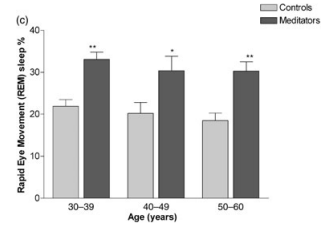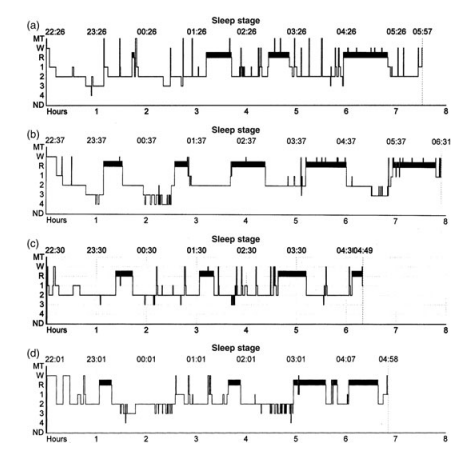Background Information
Sleep quality declines with age, especially due to the reduction in slow wave sleep (SWS)—a deep, restorative phase of sleep—and rapid eye movement (
REM
Rapid Eye Movement (REM) sleep is a sleep stage marked by vivid dreaming, rapid eye movements, and heightened brain activity similar to wakefulness. REM sleep supports emotional regulation, memory consolidation, and neuroplasticity. It typically increases in the later part of the night.
More on Wikipedia
View in glossary
) sleep, which supports emotional regulation and memory consolidation. Prior research has shown that meditation may influence biological aging and sleep patterns, possibly by enhancing neuronal plasticity and cortical thickness. This study explores whether long-term practice of Vipassana meditation helps preserve healthy sleep architecture across different age groups.
Vipassana
Vipassana is a form of Buddhist meditation focused on the cultivation of insight through moment-to-moment awareness of bodily sensations, thoughts, and emotions. It emphasizes non-reactivity and equanimity, helping practitioners observe mental and physical phenomena without attachment.
More on Wikipedia
View in glossary
meditation emphasizes mindful observation of bodily sensations and mental states, cultivating equanimity and non-reactivity. The study aimed to test whether this form of meditation supports better sleep across the lifespan, by comparing the sleep profiles of long-term meditators and non-meditators across three age groups.
What They Did
Researchers recruited 91 healthy male participants aged 30–60, including 45 senior Vipassana meditators (practicing more than 3 years, 2–4 hours daily) and 46 non-meditating controls. Participants were stratified into three age categories: younger (30–39), middle-aged (40–49), and older (50–60).
All participants underwent two nights of whole-night
EEG
An electroencephalogram (EEG) is a recording of brain activity. During this painless test, small sensors are attached to the scalp to pick up the electrical signals produced by the brain.
More on Wikipedia
View in glossary
, with the second night’s data used for analysis. Only participants with a sleep efficiency index above 85% were included, ensuring high-quality sleep data. Researchers compared various sleep metrics, including slow wave sleep, REM sleep, REM onset latency, and number of sleep cycles.
One Big Result
Across all age groups, Vipassana meditators had significantly more slow wave sleep and REM sleep compared to controls. This pattern persisted even in older meditators, while non-meditators showed a marked age-related decline in slow wave sleep. For example, older controls had a 65% reduction in SWS compared to younger controls, while older meditators maintained relatively high SWS levels. Meditators also had shorter REM onset latency and more sleep cycles.

Vipassana meditation appears to preserve deep, restorative sleep even into old age.
Miscellaneous Interesting Takeaways
Meditation Prevents Age-Related Decline in Sleep Quality
In control participants, SWS declined progressively with age, from 11% in younger men to just 4% in older men. In contrast, meditators maintained 11–18% SWS even into their 50s. This suggests that meditation may help counteract the age-related erosion of restorative sleep stages.
Controls exhibited a progressive significant reduction of slow wave sleep across age groups […] whereas meditators showed a significant decrease up to the middle-aged group and remained stable thereafter.
REM Sleep Benefits and Emotional Processing
Meditators exhibited significantly more REM sleep across all age groups. This is noteworthy because REM sleep is linked to emotional regulation and memory consolidation. Higher REM sleep in meditators might reflect enhanced emotional processing capacity and psychological resilience.
Better Sleep Architecture
Meditators showed more frequent NREM–REM sleep cycles and shorter REM onset latency. These features are associated with more organized, efficient sleep—traits typically diminished with age.
Vipassana meditators are hence endowed with all features of good sleep organization: high sleep efficiency index, enhanced slow wave sleep and REM sleep states, reduced REM onset latency, and a higher number of sleep cycles.
In essence, meditators not only slept more deeply, but their sleep followed healthier, more structured patterns.

Final Reflection
This study makes a compelling case that long-term Vipassana meditation can preserve and even enhance the quality of sleep well into older age.
Meditation may serve as a powerful tool for maintaining healthy sleep architecture, countering age-related decline in deep and REM sleep.
Citation
PATTANASHETTY, R., SATHIAMMA, S., TALAKKAD, S., NITYANANDA, P., TRICHUR, R., & KUTTY, B. M. (2010). Practitioners of vipassana meditation exhibit enhanced slow wave sleep and REM sleep states across different age groups. Sleep and Biological Rhythms, 8(1), 34–41. 10.1111/j.1479-8425.2009.00416.x